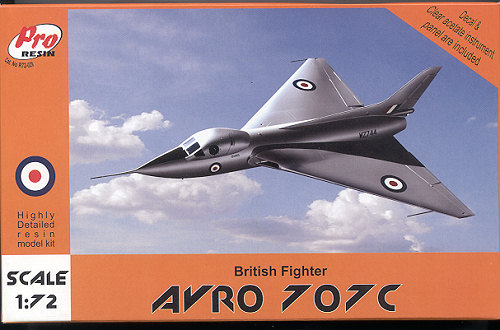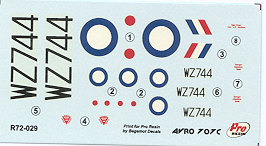
| KIT: | ProResin 1/72 Avro 707C |
| KIT #: | R72-029 |
| PRICE: | $ |
| DECALS: | One option |
| REVIEWER: | Scott Van Aken |
| NOTES: | Resin with vacuformed canopies |

| HISTORY |
The Avro 707 was a British experimental aircraft built to test the delta wing design for the Avro 698 jet bomber (later to become the Vulcan), and was a effectively a one-third scaled-down version of that aircraft.
The prototypes were ordered by the Ministry to specification E.15/48. The aircraft were produced cheaply and quickly using components from other aircraft. Five prototypes were built in the end. Only the first three produced provided useful information for the Vulcan project, the last two flying too late to be of much relevance.
The first prototype, the Avro 707, crashed on 31 September 1949. Consequently the second prototype was converted during building with the pointed nose planned for the 707A to become the 707B. The B was given the same dorsal engine intakes as the 707. The B would eventually end up as spares for the others. The next one to fly was the 707A, a faithful copy of the Type 698's wingform including engine intakes, and intended for high speed testing. In 1956 it was transferred to Australia where it served until 1967 when sold off to a local resident. The next aircraft were ordered to E.10/49 in November 1951. These were to be a second 707A and two of a side by side cockpit version - the 707C. The 707Cs would be used to give pilots experience but the second 707C was cancelled. These two flew in 1953 by which point the Vulcan prototype was already flying.
The Avro 707 made its final public appearance at the Farnborough Air Show; the four surviving examples of the aircraft flying alongside two Vulcan prototypes.
Two examples of the Avro 707C two-seat variant survive. One is located at the RAF Museum, Cosford near Wolverhampton, the other at the Museum of Science and Industry in Manchester.
| THE KIT |
 T
T he second new release from ProResin is the two seat 707C. Detail is engraved and superbly done, complete with teeny rivet patterns along the various panel lines. The vast majority of the kit is the same as in the 707A as shown to the left. On the right are those pieces that are unique to the 707C.
he second new release from ProResin is the two seat 707C. Detail is engraved and superbly done, complete with teeny rivet patterns along the various panel lines. The vast majority of the kit is the same as in the 707A as shown to the left. On the right are those pieces that are unique to the 707C.
Each of the wings is a single piece with a cutout near the fuselage for the intakes. The wheel wells are nicely detailed and seem to be the proper depth as well. Gear doors have detailing on the inner surfaces. Moving to the cockpit, there is a full tub with raised detail for both the side consoles and the instrument panel. A nice control stick and well molded bang seat are supplied with harness molded onto the seat. It is a shame that little will be seen of the interior after the canopy is installed. You may want to replace the kit seat with a metal one to aid the kit in keeping on the nose gear. There isn't much room in the nose once the interior is installed and that additional weight may well be needed, though this doesn't have as short a wheel base as the Boulton-Paul kits. The kit shows that weight is needed, but doesn't state how much.
The landing gear are nicely molded and somewhat complex, especially the nose gear, but it isn't beyond the realm of those who are at the stage of building kits like this. There are also the usual number of teeny detail bits for the outside and that includes the nose 'spear'. Care will be needed in mounting this. You'll also find that ProResin has provid ed two nice, clear canopies, in case one of them is damaged. I appreciate this as often I need to use that second offering.
ed two nice, clear canopies, in case one of them is damaged. I appreciate this as often I need to use that second offering.
Markings are provided for the one aircraft, WZ 744 The decals are nicely done and seem to be right on register. As with the previous Avro 707 kit, the decals seem to be a tad oversize. Like that kit, you can get replacements for the roundels and serials from the Modeldecal range should you decide to go that route. Of course, you can also use the kit decals if the small difference in size is not a problem for you.
| CONCLUSIONS |
I'm very pleased to see these British experimental aircraft being released. It is a part of aviation history that has gotten very little attention from the manufacturers and putting out good quality kits like this are a sure way for you to build up your collection. The kit is detailed enough for the picky and yet simple enough that one could use it for one's first resin kit. If you have an interest in aircraft like this and have the abilities, then I'd say go for it. I am!
| REFERENCES |
December 2006 My thanks to ProResin If you would like your product reviewed fairly and quickly by asite that has over 325,000 visitors a month, please contactme or see other details in the  for the review kit.
for the review kit.